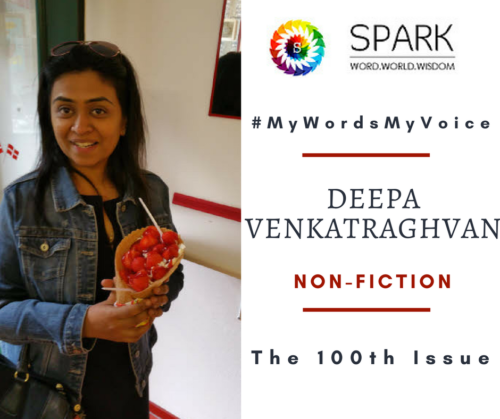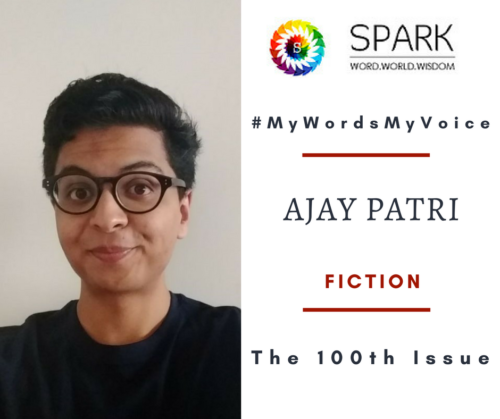by Deepa Venkatraghvan
What theme are you addressing in your piece? Why is this important to you?
Deepa Venkatraghvan: My piece is about documenting family stories to pass on to future generations. We all have family heirlooms that we hand down through generations but for me, more precious than any material possession, are the stories that built our families. As I grow older and become a decision maker and guide for my own children, I find myself reaching out to my learnings as a child and young adult. I find myself reflecting on the personalities of my grandparents and parents and how those traits built my value system. And as I pass on these learnings, I find that it is easiest through narratives of stories and events. Values like faith, trust and goodness are abstract and subjective but when put in the context of a story, the message hits home so much more effectively. I want to build a collection of stories and document them in the hope that some day my children will cherish them and perhaps keep adding to that treasure trove.
Some years ago, while waiting at the bus stop to pick my daughter up after school, I got talking with another parent. He was very excited. His wife had gifted him a DNA testing kit and he had just sent in his saliva sample. The results would come in a month and he was beyond curious to know what his ethnicity was and where his ancestors came from. A month later I followed up with him and got a complete rundown of his ethnic mix – 47% British, 30% Irish, 12% Scandinavian and the rest spread across the European region. He was excited about this finding but that was pretty much about it.
At around the same time, I had started working with a new colleague. Steve’s desk was next to mine and we hit it off quite quickly. We had many common thoughts and interests and ended up speaking a lot about heritage and family. He was a first generation American whose father had emigrated from Cuba with barely anything and built a life in America. I vividly remember him telling me a story.
‘I was getting ready for a youth football game when I was 11,’ he told me. ‘This game was unique since it was the championship game for our county. My father was driving me in his red van with well over a hundred thousand miles on it. It was one of those proud moments for him as a Cuban immigrant who had spent his youth working. He was only 12 when had emigrated to the U.S. from Havana, Cuba as a refugee. Today, he was seeing his son play football in the U.S. at nearly the same age that he was, when he was working in the U.S. to help his mother, a single parent, pay rent.’
Steve told me his dad was typically stern and intimidating but in that car ride, he saw his father getting very emotional. Something about that day made his dad open up to Steve a little. ‘That day, my dad said to me – Steve, do you know how fortunate you are to dream? I was never able to dream since I had to make a living for my family. I want you to chase your dreams and not have to worry about your financial needs throughout your childhood. There is only one thing you need to promise me. You will never quit on your goals and that you will create a better life for your family in America than I did.’ His father then let Steve have his Santa Barbara necklace for the game. ‘This necklace was very symbolic in my family. On the first day that my father and grandmother arrived in the U.S., they found themselves in Miami, Florida. They were trying to figure out where to settle down. While talking with another group of Cuban immigrants, my father had noticed a Santa Barbara necklace on the street curb. He picked it up and to this day, wears it all the time. My father believes that the necklace is his good luck charm and a symbol of his tenure in the U.S.’
So many years after this experience, Steve admitted that his father’s story made a huge impact on his life. ‘Till this day, I think about how my family put pieces together as Cuban immigrants in the United States of America. As a first generation Cuban American, I look back on these stories to remember how far my family has come and to continue to elevate each generation that comes after me.’
Steve’s story revealed to me so much more than statistics about ancestry mix. That’s the beauty of these stories – they don’t just tell us where we come from but how our ancestors lived, the things they believed in, the habits that characterised them and the traits they passed on that ultimately built our individual families and gave us direction to lead our lives.
I remember another story a friend once told me about his grandmother. He said that story had really helped him define his own goals for his family. His grandmother was a compassionate woman who never said no to her family. She accommodated all their needs and did whatever they asked from her, even if it meant migrating countries to support her husband’s career or moving cities to help her children when they had their own. One day, on a whim, one of her sons-in-law, asked her to make cherry pie for dessert. She had never heard of cherry pie and the request was mostly a tease. A few hours later, her son-in-law was served the best cherry pie he had ever eaten. ‘My grandmother kept the family together,’ my friend told me, ‘she accommodated everyone’s needs and was never too busy to look out for someone. Because of her compassion, she was always surrounded by people she loved, and she lived a really fulfilled life. My mother is a chip off that block. I can see she is trying to emulate my grandmother. She tries to bring the family together as much as she can, and I know I too want to be like that for my children.’
While unique in their own ways, these stories also resonate for all their familiarities. Steve’s father’s story is not very different from my own grandfather’s, 8,000 miles away in another part of the world. Born in a small village in Kerala, my grandfather’s sights were always set at something higher, something bigger. At 15, he tried to run away from home but was found and brought back. Not one to stay put, he ran away again and worked as a waiter at restaurants and spent nights sleeping at local temples. He worked as a cargo porter, a tradesman, a workman in a cycle shop. Not in my wildest dreams would I have imagined our grandfather doing these tedious jobs. To me, he was a successful businessman who built a big house and owned a family car – a luxury in India in those days.
My paternal grandmother was a very compassionate woman, too. She was strong-willed and followed her heart. At the same time, she conformed to social norm. It’s hard to put to words the finesse of her character but as an example, she accepted that as a woman, her place was inside the home. She was pulled out of school and married in her teens. She never complained or tried to rebel. But she did a spectacular job in her role as the woman of her home. It’s not easy keeping together a family of five sons, five daughters-in-law, a daughter, a son-in-law and an army of grandchildren. But that’s what she did. She not only kept us together, she taught us to manage our personalities and live together.
Stories of struggle, of risks, of dreams and of compassion – we all have these tales in our families and they define our character. They give us perspective on our upbringing and why we are the way we are; they help us understand that we are all the same at birth but what makes us different is the way we evolve based on our experiences. So in a way, these stories also prepare us to become more accepting of people, especially as our world is turning into one big melting pot.
The next and I believe, a very important step once we realise the importance of such stories and memories, is to document them, however small the story may be. It’s one of my personal goals to try and document as many stories that I can of my family’s history so that I can pass them on to my children in the hope that even many years later, they can continue to draw strength from their ancestry to define their own lives. One of my cousins and I share this goal and last year, we started a family blog to document stories, poems, art work from all generations of our family. Everyone, from the oldest to the youngest member contributes their thoughts. In the process, we have realised, much to our amazement, how many stories there are that even siblings or children have never heard of!
I am also trying to instill this goal in my eleven-year-old daughter. Last summer, I gave her a vacation project. She had to interview her grandparents (my parents) to learn a little about their lives. I helped her with the questions and listened to her interview them and take notes. In the process, there were things I learnt about my parents that I did not know before and it was just another reinforcement to keep working on this goal. I think if we all took one step at a time, one story at a time, we’d have a powerful library of stories that can really define how we would like to lead our lives. We don’t need to look for self-help books or TED Talks. We all have these inspirational stories, right in our homes.







Beautiful ! Deepa , I loved your idea of collecting family history by recording small stories and anecdotes. Fully agree that these do help us in understanding ourselves and our previous generations too ! All the best !